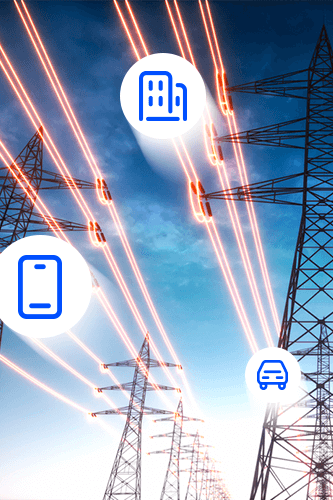Smart Grids Are Smarter Than You Think
Energy
Smart Grids Are Smarter Than You Think
Through advanced data analytics and predictive capabilities, machine learning drives smart grids to optimize energy distribution, enhance grid resiliency, and promote sustainable energy practices.
The world is actively working to address the pressing issue of climate change. On a global scale, efforts are being made to reduce carbon emissions and carbon footprint, with varying degrees of success.
Due to its resource-intensive nature, the energy industry is often regarded as one of the main culprits in environmental degradation. However, energy suppliers are constantly seeking sustainable and efficient energy production methods. Smart grids currently stand at the cutting edge of energy management as a sustainable solution for a lifelong problem.
Let’s find out how smart grids work and how they improve on conventional grids.
What is a smart grid?
A smart grid is an electricity supply network that uses digital communication technologies to monitor, analyze, and intelligently manage electricity distribution. It can sense and immediately respond to change in order to optimize power distribution.
In other technical words, a smart grid can be considered an IoT-enabled application that streamlines the exchange of electricity and data between energy providers and customers. Devices such as smart meters, sensors, and remote-control points constitute the hardware ecosystem of a smart grid, ensuring accurate collection, validation, and storage of consumption insights.
Shortcomings of a traditional grid
Today’s energy grid structure is unsustainable. It offers limited flexibility or openness to support emerging renewable technologies.
Traditional energy grids support a one-way flow of power from centralized sources, such as coal, nuclear and gas to points of consumption. When more power is needed, another centralized source of generation, has to be built. The traditional grid cannot quickly pivot in the face of acute demand spikes or support the 100% renewable energy critical to meet global climate goals.
Smart grid, beneficial grid
Backed by AI and advanced machine learning algorithms, modern smart grids can handle vast amounts of real-time data in a two-way flow, offering several benefits for both suppliers and consumers, like:
Data-based energy demand
Precision is key when determining energy demand. To support this, smart meters are installed throughout the grid to collect data on energy usage patterns, voltage levels, and load capacity, among other metrics. Machine learning algorithms analyze this data, enabling energy providers to tailor their energy production according to the obtained results. Over time, this leads to more efficient grid operation, with less energy waste and greater cost savings.
Reducing peak loads
Suppliers can improve the management of peak energy demand by training machine learning models to forecast periods of high demand and adjust the energy supply dynamically. This balancing prevents the grid from becoming overloaded during peak times, diminishes the strain on infrastructure, and almost eliminates the need for support by additional power plants.
Proactive failure management
With the right use of IoT devices such as sensors, machine learning algorithms continuously monitor the grid for any signs of potential faults or failures. By identifying issues early and conducting preventative maintenance, suppliers can deploy rapid response teams to address these faults before they lead to damaging power outages/downtime, improving supply reliability and extending the lifespan of grid infrastructure along the way.
Real-time insights
For consumers, smart grids not only provide uninterruptable, high-quality service but also a window into their consumption habits. Detailed insights about energy usage patterns are presented in real-time, encouraging sustainable behaviors and cost savings.
Sustainability
As environmental regulations are passed worldwide to promote sustainable practices, the energy industry is increasingly adopting smart grids to minimize power wastage. In fact, the smart grid market is forecast to grow at a Compound-Annual Growth Rate (CAGR) of 17.4 percent until 2028, and it is estimated to reduce CO2 emissions by up to 2.2 gigatons by 2050.
The future is renewable energy… and smart grids
The future of smart grids is closely tied to the development of renewable energy sources, such as solar and wind. As these sources become more prevalent, machine learning will be essential in managing their variability and integrating their output with traditional energy sources. This merging will contribute to a stable and reliable energy supply while maximizing the environmental benefits of renewable energy.
Also, smart grids will be able to connect consumption signals directly to production, enabling a more coherent and responsive energy system. As more and more renewable energy sources come online, the need for smart grids will only continue to grow.
Wrapping up
The complexity of the energy industry is tied to a diverse range of logistical and economic constraints, but this doesn’t seem to stop technology from creating a positive disruption within. Once smart grids are in full effect, the industry is set for meaningful change that will spread to various facets of society. And with the continuous evolution of IoT and machine learning, the sky is the limit for upcoming innovation.





